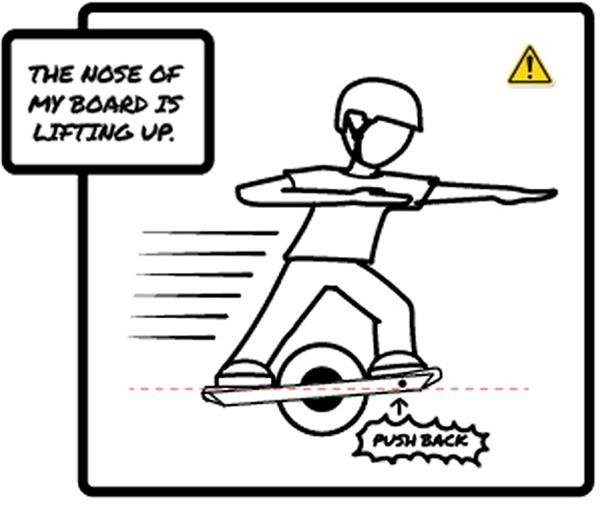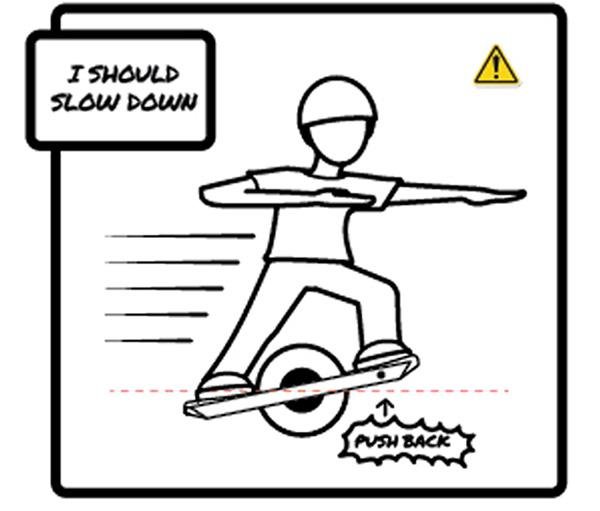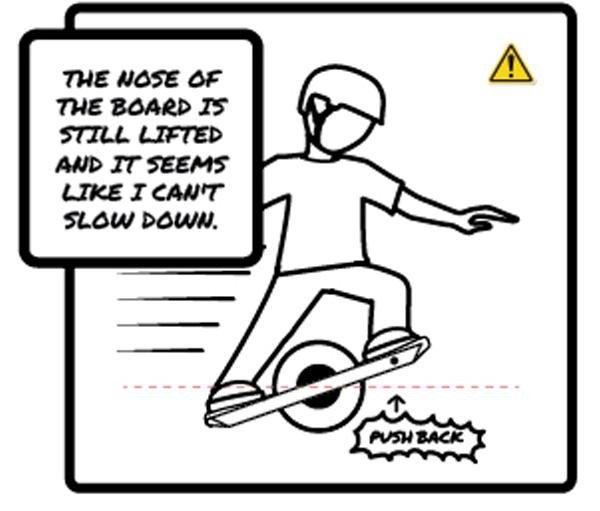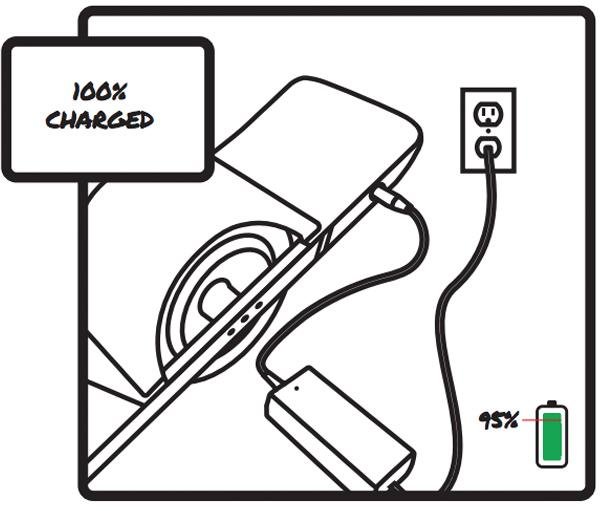Onewheel+ XR/pint
Basic Operations
Switch to Onewheel+ using power switch on the side.
Step fully and firmly on both sides of the blue dividing line.
Always wear a helmet.
Lean on a friend to get started.
Slowly come up for balance.
Onewheel+ will engage when you reach a horizontal orientation.
Lean forward to accelerate.
Lean back to slow down.
Lean side-to-side to turn.
Slow down to < 1 mph and with your toe planted, lift your heel from one side of the rider dtection area.
You can also jump off with both feet, but never remove only one foot.
REGENERATIVE BRAKING
Decelerating while going downhill recharges the Onewheel+ battery.
WARNING Riding hills exceeding a 15% grade is extremely dangerous and may result in loss of control or damage to your Onewheel+.
UNDERSTANDING THE FOOTPAD
The front footpad is pressure sensitive and divided into two zones - one on each side of the central line. Both zones must be pressed to begin riding. To stop, slow to a standstill and then remove your feet from one/both zones.
TIP: Avoid repositioning your foot while riding.
DIRECTION AND SPEED
Lean forward to move forward, and lean back to slow down or to move backwards. The more you lean the faster you’ll go.
TURNING
Use subtle heel-toe pressure for turning left or right. You will begin to turn in the direction you lean. The more you learn, the sharper the turn.
MAIN POWER PUSH BUTTON SWITCH
Onewheel+ is powered ON and OFF by the pushbutton switch on the side of the Onewheel+. Always make sure your Onewheel+ is on the ground in the ready-to-ride position before switching it “ON.” Always turn your Onewheel+ “OFF” when charging, storing or carrying it.
WARNING: Never pick up your Onewheel+ when the switch is in the “ON” position since the wheel may spin, thus causing a safety hazard.
CAUTION: Do not press the rider-detection area section of the footpad while powering on your Onewheel+ or it will not operate.
TIP Turning on your Onewheel+ while it is not on the ground will cause an error.
STATUS INDICATOR
LED STATUS RING INDICATOR The LED ring on the pushbutton switch is the only status indicator for Onewheel+. The LED will indicate battery status and error codes for your Onewheel+.
Normal Operation The LED Status Indicator will pulse slowly under normal operating conditions.
Battery Status As the battery capacity diminishes your ride, the LED Status Indicator will change its rate of pulsing so that the LED Status Ring indicator will remain off longer than it is on. This ratio of ON/OFF time indicates the current battery status. You can also check your battery status from the home screen of the Onewheel app.
Using The App
DOWNLOAD OUR APP
Sync to your board from the Onewheel app to customize your riding experience with Digital ShapingTM. The Onewheel app also allows you to check our battery status for epic adventures, toggle your LED lights for night cruising and track riding data.
TIP: Search "Onewheel" on Google Play or Apple App Store.
DIGITAL SHAPING
Sync to your board from the Onewheel app to customize your riding experience. Digital Shaping 2.0 provides the pinnacle of performance, comfort and control. Inspired by surfboard shapers creating different boards for different rides, Digital Shaping 2.0 offers a complete quive of Shapings selectable from your smartphone.
PUSH BACK
Like everything in life, Onewheel+ has its limits. If at any time you attempt to go too fast, descend a very steep hill or ride with a low battery, your Onewheel+ will “push back.” In a push back situation, the nose of the board will lift to slow the rider down. The only way to avoid push back is to decrease your speed by leaning back. If you’d like to go a bit faster, you can switch your Digital Shaping to a more aggressive setting. This will have a higher threshold for push back.
A key distinction here is that push back is not an arbitrary speed limit which we have decided upon to hold you back, it’s actually the limit that the board can safely go. Push back is a function that is defined by a number of parameters including but not limited to battery %, grade of terrain, speed, tire pressure, rider weight. It is really important to understand that you can defeat push back. If you continue to lean forward and accelerate you are essentially asking the board to go faster than it can manage and on one wheel, there is little power left to maintain balance and stability. In order to avoid a loss of control, make sure you ease up when you experience push back and you’ll be good to go.
WARNING: Ignoring safety warnings, including push back, may result in loss of control, serious injury or death.
FULL-BATTERY PUSH BACK
When the battery is fully charged and you continue to charge it through regenerative braking (e.g., traveling downhill), you may experience “Full-Battery Push Back.” This is to prevent overcharging the battery cells. If this happens, simply switch your Onewheel+ OFF and ON again, and travel up the hill for a few moments to expend some of the charge. You will now be able to continue riding downhill.
WARNING: Never attempt to ride down a long or steep hill with a freshly charged Onewheel+. Loss of control or damage to your Onewheel+ may occur.
LOW-BATTERY PUSH BACK
When your Onewheel+ battery is extremely low, it will perform a much more aggressive push back and will become inoperative. This means a full battery charge is needed.
WARNING: Continuing to ride when low-battery push back occurs may result in sudden shutdown or damage to your Onewheel+.
SPEED PUSH BACK - DO THIS
Push back is an important feature. Ignoring or trying to push through push back is extremely dangerous.
CAUTION: PUSH BACK
The nose of the board lifts up to warn the rider to slow down.
CAUTION: PUSH BACK
The rider recognizes push back and plans to adjust.
Rider shifts weight to the back foot in order to slow down.
Rider has slowed down and the board returns to riding normally.
SPEED PUSH BACK - NEVER DO THIS
Push back is an important feature. Ignoring or trying to push thrugh push back is exremely dangerous.
CAUTION: PUSH BACK
The nose of the board lifts up to warn the rider to slow down.
WARNING: DO NOT IGNORE PUSH BACK
If the rider’s weight continues to be forward the board will continue to give the rider push back.
WARNING: DO NOT IGNORE PUSH BACK
Rider leans weight forward to accelerate. Board continues to try to push rider back.
WARNING: DO NOT IGNORE PUSH BACK
Ignoring safety warnings, including push back, make result in loss of control, serious injury or death.
FULL BATTERY PUSH BACK - DO THIS
Push back is an important safety feature. Ignoring or trying to push through push back is extremely dangerous.
Onewheel is 100% charged.
CAUTION: PUSH BACK
Ride uphill until the batter is below 95% charged.
After draining the battery under a 95% charge, the battery is ready for regenerative braking.
Good to go, have fun.
FULL BATTERY PUSH BACK - NEVER DO THIS!
Push back is an important safety feature. Ignoring or trying to push through push back is extremely dangerous.
Onewheel is 100% charged.
WARNING: DO NOT IGNORE PUSH BACK
The nose of the board lifts up to warn the rider the battery can’t handle any more regen braking.
WARNING: DO NOT IGNORE PUSH BACK
If regenerative braking continues the board will continue to push back.
WARNING: DO NOT IGNORE PUSH BACK
Ignoring safety warnings, including push back, may result in loss of control, serious injury or death.
Charging
BATTERY CHARGER
Use only the provided Ultracharger to charge your Onewheel+, or the XR Charger for your Onewheel+ XR. NOTE: Both chargers can operate on 110V-240V. Depending on your country, a plug adapter may be required.
BATTERY
Be careful not to overcharge or undercharge your battery. The battery should be charged at least once every two months. Failure to do so may void your warranty. You must dispose lithium batteries according to local laws and regulations.
WARNING
If the battery pack appears to be damaged or is not holding a charge, please don't use it. For further assistance, contact Onewheel+ customer support at 1-800-283-7943 or send an email to support@onewheel.com.
CAUTION
Do not expose the battery to extreme high or low temperatures. These may degrade or damage the battery pack.
HOW TO CHARGE YOUR BATTERY
Connect the charger to an "AC" supply and then to the Onewheel+ charging port. The charger will display a red light.
A green light will appear when the battery pack is fully charged, and the charger will automatically stop charging.
Disconnect the charger by pressing the release button on the charging plug and pulling firmly.
TIP: Periodically leave the charger attached to your Onewheel+ overnight to allow the battery pack to thoroughly balance.
CAUTION
Only use the Ultracharger charger to charge your Onewheel+, or the XR Charger to charge your Onewheel+ XR. Use of any other charger will void your warranty and may damage your Onewheel+.
CAUTION
All electronic and drive components may only be repaired by Future Motion or by an Onewheel+ authorized service center. Any other adjustments will void your warranty.
CAUTION
Don't begin any repairs or adjustments on your Onewheel+ until you properly understand how to complete them. An improper adjustment or repair may result in damage to your Onewheel+ or a potentially serious injury. A qualified Onewheel+ mechanic should perform complex services, maintenance, and repairs in a properly equipped facility.






























